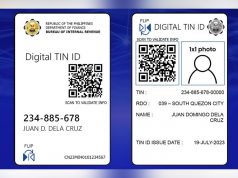
The prospect of Filipinos printing out a digital version of their national identification cards earned fresh disappointment from some applicants who endured long lines and a lengthy waiting period to get its physical form.
The Philippine Statistics Authority (PSA) announced that various formats of the Philippine Identification System (PhilSys) digital ID, including the printed ePhilID, are now accepted as “valid and sufficient proof of identity and age, subject to authentication.”
The ePhilID refers to the digital version of the Philippine identification card which can be stored in the holder’s mobile device.
“While waiting for the physical PhilID, [the] printed ePhilID allows the registrants to immediately enjoy the benefits of being registered to PhilSys,” a regional office of PSA said.
“The digital PhilID will have the same functionality and validity as its physical PhilID while PSA will continue to fast-track the printing and delivery of the physical card,” it added.
The PSA said that the ePhilID contains a security feature shared with the physical ID.
It also contains the person’s PhilSys card number and basic demographic information such as last name, given name, middle name and suffix (if available), sex, blood type, marital status (if declared), date and place of birth, front-facing photo, address, generation date, and a QR Code.
The QR code has select demographic details and the registrant’s front-facing photo for easier verification. It also uses public-private key cryptography to ensure that the information in the code cannot be tampered with.
The printed version of the ePhilID, according to PSA, shall be honored as a government-issued identification document for transactions in all national government agencies, local government units, government-owned and controlled corporations, government financial institutions, financial institutions, and the private sector.
It will serve as an alternative for those who have not yet received their physical national ID.
The PSA said that those who fail to recognize the document as the only official identification of the holder without sufficient cause would be penalized under Section 19 of Republic Act 11055 or the Philippine Identification System Act.
Filipinos issued with a PhilSys Number (PSN) or those who have successfully registered with PhilSys may avail of the ePhilID.
They need to make an appointment through the PhilSys website and show the transaction slip to their selected PhilSys Registration Centers on the reserved date.
The printing of the ePhilID is only available to Metro Manila, Bulacan and Pampanga residents so far.
Meanwhile, the advice to print it failed to impress some Pinoys who noted how much the government allocated a budget for the much-hyped national ID.
“The government had a PHP 3.52 billion budget for the National ID. Get that. So don’t go around hailing your chosen candidates and expect me to have a smile on my face,” a Twitter user wrote.
The online user was referring to the additional amount approved in 2020 for the implementation of the national ID system in 2021.
At that time, then-presidential spokesperson Harry Roque said the funds would be used to register 20 million more Filipinos in the PhilSys.
For 2023, a total of P2.05 billion budget from the National Economic Development Authority will be used for the implementation of the PhilSys Act.
Another Twitter user recalled the arduous process of securing a national ID which they expect to be given in its physical form.
“Bro, we spent hours in line for this s*it, only to find out we have to print it ourselves? Patawa,” she wrote in response to the reports.
“I paid tax for me to pay again and print my ID????? Are you insane?????” another Twitter user exclaimed.
“Print your own, laminate your own. What a scam,” a different Pinoy commented.
The national ID system aims to establish a single identification card or system for all citizens in the Philippines.
It shall serve as a valid proof of identity by simplifying public and private transactions, enrollment in schools and opening bank accounts, among others.
According to Negros Occidental Chief Statistical Specialist Luis Gonzales, the government aims to release about 50 million national IDs by the end of 2022.
30 million of that will be on plastic card, while 20 million will be on special paper containing the ID holder’s QR code and demographic data.
Gonzales said the volume of national IDs to be printed proved to be a huge task requiring a longer time to deliver.
“The data of the registrants will undergo deduplication (removing of redundant data) process before assigning a permanent unique ID number and proceed to print,” Gonzales said last month.








